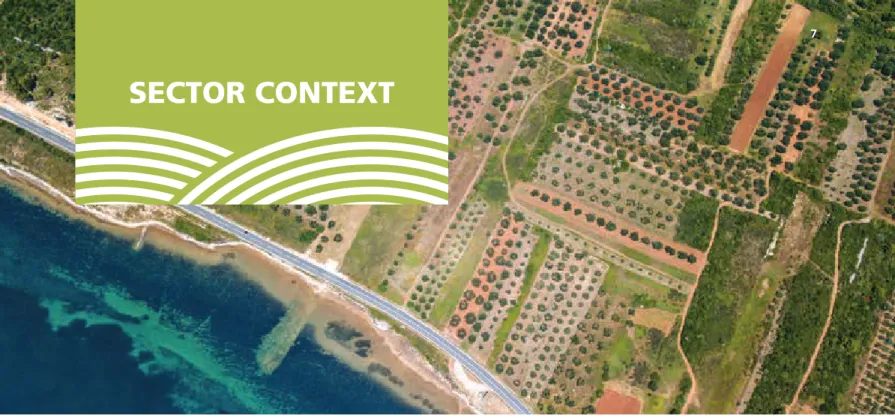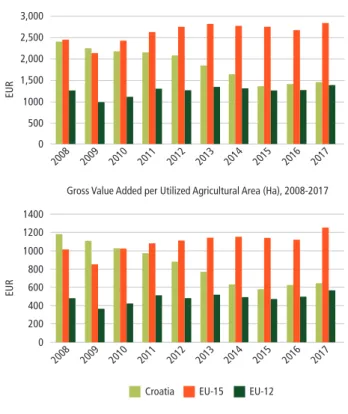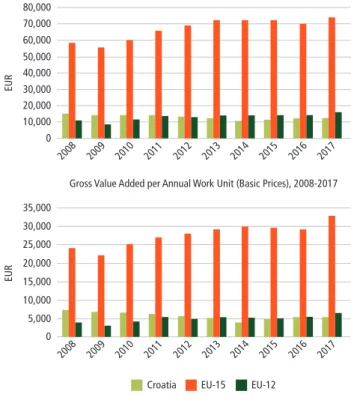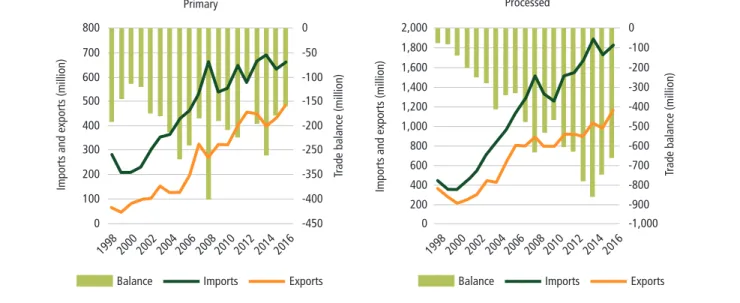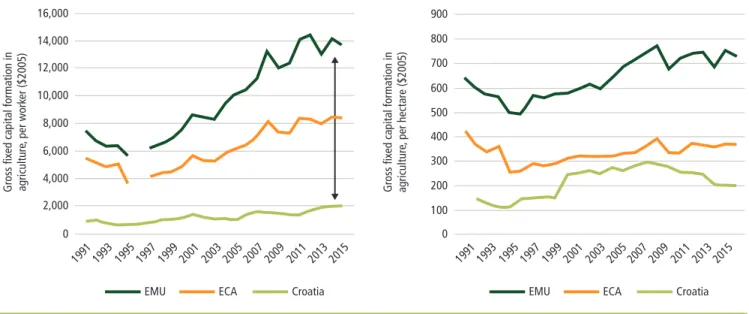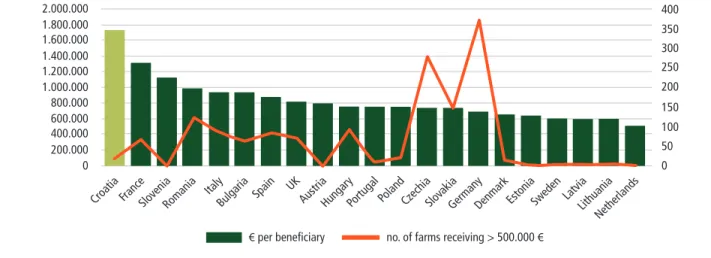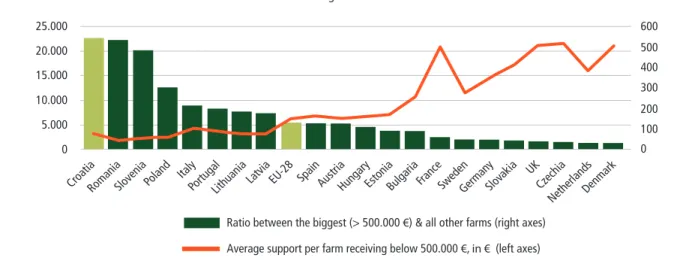The agri-food sector makes an important contribution to the economy and rural incomes in Croatia. Strengthening the competitive position of the agri-food sector will require improvements in the (i) land and labor productivity of the primary sector, including its modernization and diversification towards value addition and greater dependence on knowledge and innovation; (ii) improved ability of agri-food supply chains to respond cost-effectively to growth opportunities in domestic and international markets, while enabling broader sector integration; and (iii) the ability to manage increasing climate and market risks. Although the contribution of primary agriculture to the economy is declining as the sector merges with other EU countries in the process of structural transformation, the economy-wide impacts of the wider agri-food sector in Croatia are significant.
Many farms in Croatia (60% of farms in the agricultural register, representing 94% of the standard production of Croatian agriculture) benefit from direct payments (almost 101,000 beneficiaries in 2017). Although most of the income support (80%) is decoupled (area-related), coupled (production) support is still widely used in Croatia. Supporting the introduction of rural development investments in Croatia is a step in the right direction.
Aligning public spending in Croatia with the needs of the sector will require a rethinking of the agricultural policy mix.
Economic Performance
SECTOR CONTEXT
The structural transformation of the Croatian agricultural sector, while moving towards convergence, is still incomplete (Figure 2). In particular, the allocation of state-owned agricultural land suffers from inefficient and lengthy administrative procedures, mainly due to inconsistencies. , which is much higher than the 1.6% of EU-28 gross value added. Overall, land productivity in Croatia is limited by the prominent role of low-value commodities in Croatia's production structure, with approximately two-thirds of the country's arable land devoted to the production of low-value grains.
While gradually increasing across the EU, labor productivity in Croatia's agri-food sector fell by 1.9% per year on average between 2008 and 2017 as measured by gross agricultural output per capita. annual work unit and with 2.6% per year on average measured by gross value added per annual work unit. Although increasing in constant prices (as shown in Figure 1), Croatia's labor productivity levels are less than 20% of the levels achieved in the EU-15. Low level of productivity contributes to the weakening of the competitive position of Croatia's agricultural sector.
14 Croatian trade flows in agri-food products have increasingly moved to other EU countries. Investment gaps in capital, technology and R&D persist in the Croatian agricultural sector, further hampering productivity. The Croatian agri-food sector is characterized by many small producers and a weak producer organization22, with limited links to the markets.
Despite the high level of liquidity in the Croatian banking system and relatively low commercial interest rates (3-5%) for agricultural loans, access to capital for many agro-food producers and processors in Croatia is limited, especially for small and medium-sized enterprises, and is concentrated in two sub-sectors (81 %) – pig and poultry farming and crops26. Despite these challenges, Croatia's agri-food system is on the path of convergence (Figure 2 above) to improve agricultural productivity, reduce its dependence on the primary sector and loosen the links between poverty and agriculture. Although this process will take some time, there are considerable opportunities to accelerate the structural transformation of Croatian agriculture.
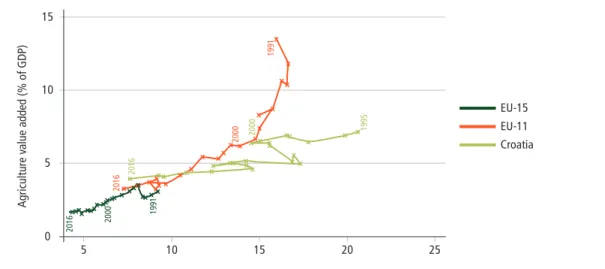
Agricultural Policy
Agricultural labor productivity, defined as growth in agricultural value added per worker, is found to be positively associated with decoupled payments and rural development value added per worker, is found to be positively associated with decoupled payments and rural development support, especially in new countries. EU Member States. A 10% increase in decoupled payments and rural development support could increase agricultural labor productivity growth in the new EU Member States by 3% to 5% per year, much greater than the 1.3% effect up to 1.6% in the old EU Member States (World Bank, 201743). The absorption of EU rural development funds, although lower than the EU average, has improved significantly over the last two years.
Croatia's Rural Development Program (RDP) currently covers a total of 18 (out of 20) measures47 in support of all 6 EU rural development priorities and all 3 cross-cutting objectives of innovation, environment and climate change mitigation and adaptation. However, rural development expenditure has not yet capital accumulation on the farm or the provision of public goods enabled in a way that improves sector competitiveness, innovation and sustainability.With the current EU budget program cycle reaching its final phase (the deadline is 2023), Croatia is 22nd in the EU-28, slightly behind the absorption of rural development funds compared to the EU average (amounts paid in Croatia from ELFPO including interim payments are at 33% of the national envelope for the programming period 2014-2020 against 42% for the EU as a whole, as of March 2019 ).
Progress in the implementation of the investment measures49 and the IACS rural development measures50 indicate that the financial resources will be fully used. However, for some non-investment measures there is a risk that not all available funds for rural development will be committed, including for cooperation (M16), producer organizations (M9), knowledge transfer (M1) and agricultural and forestry advisory services (M1). 46 Halfway through the programming period, Croatia had committed only 30% and spent only 17.6% of the €2.4 billion Pillar II rural development budget during the 2014-2020 programming cycle.
By the beginning of the fourth quarter of 2018, Croatia had signed contracts for rural development projects worth over 1.2 billion euros, representing more than 50% of the total rural development budget. In addition, more than 50% of the committed rural development funds had been disbursed, meaning that 30% of the total program allocation has now been disbursed. 48 Variations in the uptake of rural development funds can be partly justified by the fact that Croatia is the only EU Member State implementing the rural development program for the first time.
Efficiency, Effectiveness and Equity of Spending in Agriculture
Although microfarms in Croatia (and in other countries in the region) are the “champions” of technical efficiency, they are not able to become efficient at scale if there are no external enabling factors that apply to them. Since 2014, large farms have made significant gains in their share of both total subsidies and direct payments (Figures 7 and 8). In general, medium-sized farms appear to receive a higher share of direct payments (compared to their share of total subsidies), while the opposite is observed for micro and small farms.
Croatia is third among the EU-28 for financial year 2017 (after Slovakia and the Czech Republic) by the share of the total direct payments envelope directed to beneficiaries receiving more than EUR 500,000. The distribution of total farm subsidies57 and direct payments has shifted from favoring grain and other field crops to favoring specialist dairy and livestock farms58 and on-farm diversification. A remarkable increase in the share of support is observed for specialist mixed crop farms, indicating a shift towards greater support for on-farm diversification.
The opposite is observed in the case of sheep and goat farms, cattle and mixed crops. The variable includes direct payments (linked and decoupled), total support for rural development (excluding investments), subsidies for intermediate consumption, on external factors (wages, rents and interest) and other subsidies (e.g. grants and subsidies for disasters). Although Croatia is estimated to have among the lowest levels of average prices for arable land in the EU (with only Romania and Estonia recording lower levels in 2016), arable land prices have increased between 8-10% between 2015 and 2017, especially in continental countries. region (EUROSTAT).
The amount of agricultural land rented in the EU is on average 54% (higher for new EU member states). The output of $1 million of primary agricultural output leads to an estimated increase of $1.65 million in total output in the economy (in 2014). When the total effects are taken into account (including the effects of consumer spending), 1 million generates USD in agricultural production an increase of 5.19 million. USD of total production in the economy.
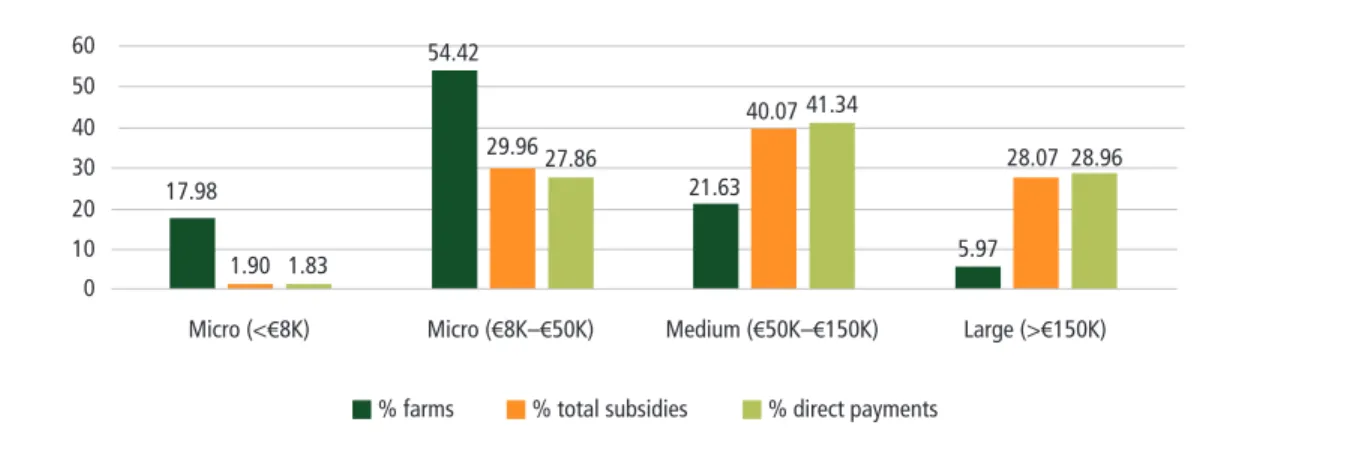
POTENTIAL
Therefore, improving agricultural productivity is essential for sector growth and the successful transition of the wider agri-food system. The enabling environment for primary agriculture and food processing is shaped by a wide range of factors that affect the degree of integration and overall competitiveness of the agri-food system. Improving agricultural risk management is an opportunity to build the sector's resilience to climate variability.
Weak horizontal (between producers) and vertical (between producers and the agri-food processing industry) integration limits the development and expansion of well-functioning agri-food value chains in Croatia. 69 The tax reform of 2018 brought a reduction in VAT from 25% to 13% on several agri-food products (meat, fruit and vegetables), making these domestic products more affordable for consumers in Croatia. Empirical estimates show that filling half the gap in the stock of agricultural capital per worker compared to the EU-28 level would increase labor productivity in agriculture by 25% in Croatia72.
Reducing differences in the distribution of income support should be an integral part of changes in the agricultural policy mix. In addition, large individual differences in the value of payment entitlements allocated under the BPS could be moved to a uniform level to ensure a fairer distribution of direct payments between farms of different economic sizes. The analysis of the structure of agricultural holdings and the distribution of rights in Croatia shows that higher thresholds for the area and the financial envelope for additional payments would lead to a more even distribution of direct payments.
Although Croatia still has a high carbon intensity of the economy, which is about 20% higher than the EU average, the carbon intensity of agricultural production in Croatia (0.18%) was significantly lower than the EU average. of 0.3% for EU-15 and 0.4% for EU-11 during pre-accession (2012). Croatia's agri-food sector is one of the most promising sectors for harnessing the potential of digital tools for smart growth and the knowledge economy, improving productivity, environmental sustainability and connectivity throughout the agri-food system. Possible future use of financial instruments (FI) in the agricultural sector of Croatia in the programming period 2014-2020.
Co-products and by-products (AWCB) data generated along the animal, fruit, grain and vegetable value chains. Detailed payments for agriculture and rural development at beneficiary level and at aggregated provincial and national levels. An illustrated user's guide to the global input-output database: the case of global automobile production.
